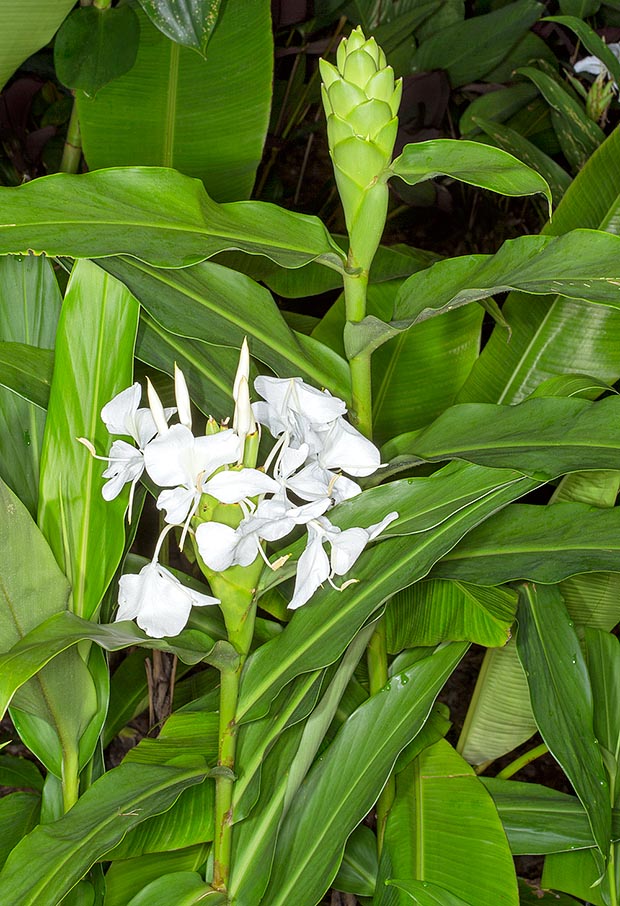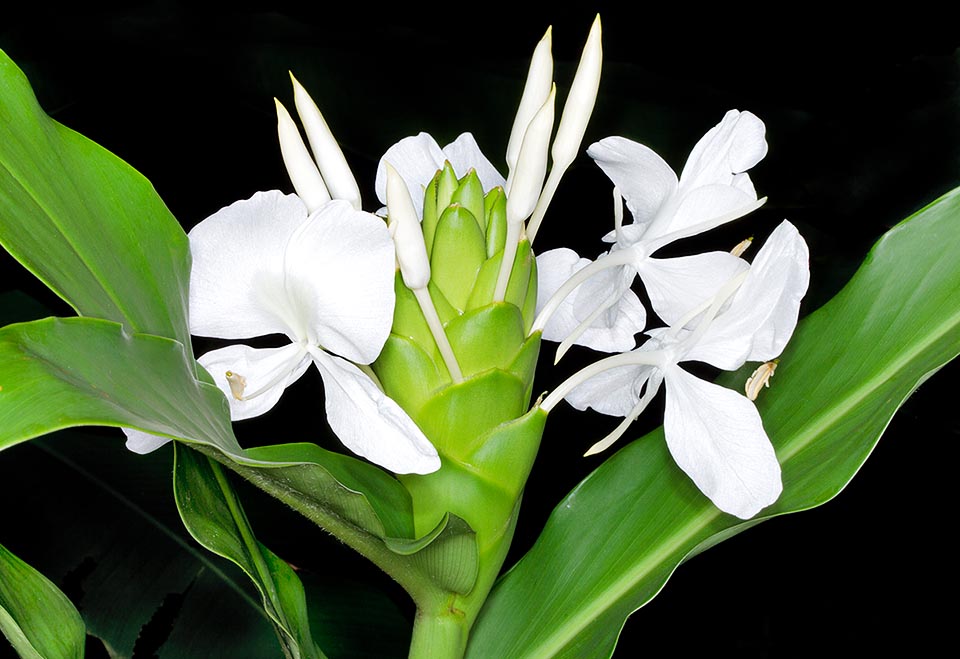Family : Zingiberaceae

Text © Pietro Puccio

English translation by Mario Beltramini

Showy ginger kin, the Hedychium coronarium is a perennial herbaceous species of South-East Asia with solid tuberous creeping rhizomes, quite superficial, and 0,5-2 m erect pseudostems © Giuseppe Mazza
The name of the genus is the combination of the Greek adjective “ἠδύς” (edys) = sweet and of the substantive “χιών” (chion) = snow, with reference to the colour of the flowers of the Hedychium coronarium, the type species; the specific name comes from the Latin “coronarius, a, um” = of crown, because of the flowers used for realizing garlands.
Common names: butterfly ginger, butterfly-lily, cinnamon-jasmine, garland-flower, white-ginger, white ginger-lily (English); jiang hua, tu qiang huo (Chinese); hédychie couronnée, longose blanc (French); dolan champa (Hindi); suruli (Kannada); angouba (Manipuri); dudh kevara, suli (Nepalese); barboleta, gengibre-branco, lágrima-de-vênus, lírio-do-brejo (Portuguese – Brazil); flor de mariposa (Spanish); kamia (Tagalog); opuhi tea (Tahitian); cankitam, kakkuram (Tamil); kicciligadda, vasa vasanthi (Telugu); hanghong, mahahong, tha-hern (Thai).
The Hedychium coronarium J.Koenig (1783) is a perennial herbaceous species with tuberous rhizomes creeping rather superficially and erect pseudo-stems, 0,5-2 m long, with alternate sessile leaves, distichous, lanceolate with long pointed apex, of glossy intense green colour above, slightly pubescent below, 20-40 cm long and 4-8 cm broad. Erect terminal inflorescence compact, ellipsoid, 10-18 cm long, formed by ovate imbricate bracts with rounded or slightly pointed apex, of green colour, about 5 cm long and 3 cm broad, each one subtending 2-6 hermaphroditic flowers, but self-incompatible, white and intensely scented opening in succession. Tubular calyx open on one side, 4 cm long, corolla with thin tube about 8 cm long and 3 linear-lanceolate lobes longitudinally crumpled (convoluted), folded, 5 cm long and 0,8 cm broad, petaloid lateral staminodes oblong-lanceolate with rounded apex, about 5 cm long and 2 cm broad, obcordate labellum with yellow-greenish spot at the base, about 5 cm long and broad, divided at the apex in two ovate lobes, filament, 3 cm long, enclosing the style, with 1,5 cm long anther and stigma projecting little more. The fruits are trilocular oblong capsules, about 3 cm long, containing numerous ovoid seeds, 0,5 cm long, provided of red sticky aril.
It reproduces by seed, that has a short lasting germinability, previously kept in water for two days, in draining loam maintained humid at the temperature of 22-24 °C, with germination times of 2-3 months or more, but usually and easily by division in late winter.
Species of easy cultivation amply utilized as ornamental thanks to the candid scented flowers in all tropical, subtropical countries where often has naturalized becoming in some instances invasive, and warm-temperate; it seems that it can bear at level of rhizome, if well mulched, temperatures up to about -10 °C for a very short period. It requires an exposition in full sun or a slight shade and is not particular about the soil, but grows best in the fertile ones maintained almost constantly humid; in the climates with dry summers, like the Mediterranean ones, needs therefore frequent and abundant waterings; useful are the fertilizations with balanced products.

Ellipsoidal 10-18 cm terminal inflorescence, with imbricate bracts and large perfumed corollas. Cultivable even in temperate warm climates. Medicinal properties © G. Mazza
Despite being an exotic species, in Cuba, where it has naturalized in vast areas, has been chosen as national floral symbol. The flowers, in the origin countries as well as in many countries where has been introduced, are utilized as decoration of the hairs and for making garlands. The stems contain about the 45% of cellulose and are utilized in the paper production; the essential oil extracted from the flowers is employed in the perfume industry.
Since remote times the species is utilized in the traditional medicine for various pathologies; laboratory studies have revealed in the extracts of various parts of the plant the presence of bioactive compounds with interesting analgesic, antiallergic, anti-inflammatory, antitumoral, anti-hypertensive and hepatoprotective properties which might be used in the official pharmacopoeia.
Synonyms: Kaempferia hedychium Lam. (1791); Hedychium spicatum Lodd. (1822); Hedychium maximum Roscoe (1824); Hedychium lingulatum Hassk. (1839); Hedychium chrysoleucum Hook. (1850); Hedychium gandasulium Buch.-Ham. ex Wall. (1853); Hedychium prophetae Buch.-Ham. ex Wall. (1853); Hedychium sulphureum Wall. (1853); Gandasulium coronarium (J.Koenig) Kuntze (1891); Gandasulium lingulatum (Hassk.) Kuntze (1891); Amomum filiforme Hunter ex Ridl. (1909).
